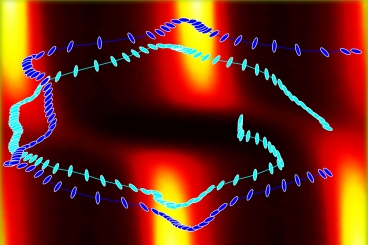The findings were the result of microscopic analysis of bacteria inside microfluidic devices and combined experimental observations with mathematical modeling. The study showed that the flow of liquid can have two significant effects on microbes: “It quenches the ability of microbes to chase food,” says co-author Roman Stocker, an assitant professor of civil engineering at MIT, “and it helps microbes find surfaces.”
That second finding could be particularly beneficial: Stocker says in some cases, that phenomenon could lead to new approaches to tuning flow rates to prevent fouling of surfaces by microbes — potentially averting everything from bacteria getting a toehold on medical equipment to biofilms causing drag on ship hulls.
The effect of flowing water on bacterial swimming was “a complete surprise,” Stocker says. “My own earlier predictions of what would happen when microbes swim in flowing water had been: ‘Nothing too interesting.' It was only when Roberto and Jeff did the experiments that we found this very strong and robust phenomenon.”
The study was done with MIT post-doctoral researcher Dr. Roberto Rusconi, and Jeffrey Guasto, an assistant professor of mechanical engineering at Tufts University.
Even though most microorganisms live in flowing liquid, most studies of their behavior ignore flow, Stocker explains. The new findings show, he says, that “any study of microbes suspended in a liquid should not ignore that the motion of that liquid could have important repercussions on the microbes.”
The novelty of this result owes partly to the divisions of academic specialties, and partly to advances in technology, Stocker says. “Microbiologists have rarely taken into account fluid flow as an ecological parameter, whereas physicists have just recently started to pay attention to microbes,” he says, adding: “The ability to directly watch microbes under the controlled flow conditions afforded by microfluidic technology — which is only about 15 years old — has made all the difference in allowing us to discover and understand this effect of flow on microbes.”

Charts of the probability that a bacterium will have a given orientation, at three different positions in the moving stream of water, are plotted based on experimental data (solid lines) and mathematical models (dashed lines), showing how well the two agree. Credit: the research team
The team found that swimming bacteria cluster in the “high shear zones” in a flow — the regions where the speed of the fluid changes most abruptly. Such high shear zones occur in most types of flows, and in many bacterial habitats. One prominent location is near the walls of tubes, where the result is a strong enhancement of the bacteria’s tendency to adhere to those walls and form biofilms.

Bacteria swimming in flowing water are shown in this diagram of a mathematical model of their motions by the researchers. The background colors show the orientation of the cells' long axis (horizontal axis) and their position across the width of the stream (vertical axis). Superimposed on that are two representative examples of bacteria, showing their changing orientation, and revealing that they spend much more time aligned with the flow (horizontal) than perpendicular to it (vertical). Credit: the research team
But this effect varies greatly depending on the speed of the flow, opening the possibility that the rate of biofilm formation can be tweaked by increasing or decreasing flow rates.
Guasto says the new understanding could help in the design of medical equipment to reduce such infections: Since the phenomenon peaks at particular rates of shear, he says, “Our results might suggest additional design criteria for biomedical devices, which should operate outside this range of shear rates, when possible — either faster or slower.”
“Biofilms are found everywhere,” Rusconi says, adding that the majority of bacteria spend significant fractions of their lives adhering to surfaces. “They cause major problems in industrial settings,” such as by clogging pipes or reducing the efficiency of heat exchangers. Their adherence is also a major health issue: Bacteria concentrated in biofilms are up to 1,000 times more resistant to antibiotics than those suspended in liquid.
The concentration of microbes in the shear zones is an effect that only happens with those that can control their movements. Nonliving particles of similar size and shape show no such effect, the team found, nor do nonmotile bacteria that are swept along passively by the water. “Without motility, bacteria are distributed everywhere and there is no preferential accumulation,” Rusconi says.
The new findings could also be important for studies of microbial marine ecosystems, by affecting how bacteria move in search of nutrients when one accounts for the ubiquitous currents and turbulence, Stocker says. Though they only studied two types of bacteria, the researchers predict in their paper that “this phenomenon should apply very broadly to many different motile microbes.”
In fact, the phenomenon has no inherent size limit, and could apply to a wide range of organisms, Guasto says. “There’s really nothing special about bacteria compared to many other swimming cells in this respect,” he says. “This phenomenon could easily apply to a wide range of plankton and sperm cells as well.”
Published in Nature Physics. Source: David Chandler, MIT




Comments